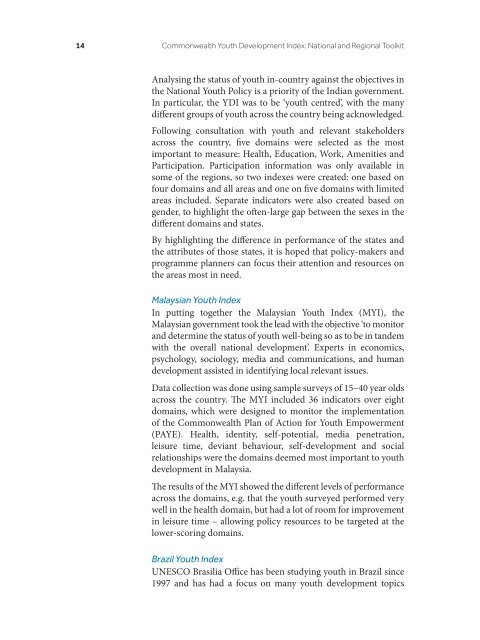Commonwealth Youth Development Index
b19vs_f
b19vs_f
You also want an ePaper? Increase the reach of your titles
YUMPU automatically turns print PDFs into web optimized ePapers that Google loves.
14 <strong>Commonwealth</strong> <strong>Youth</strong> <strong>Development</strong> <strong>Index</strong>: National and Regional Toolkit<br />
Analysing the status of youth in-country against the objectives in<br />
the National <strong>Youth</strong> Policy is a priority of the Indian government.<br />
In particular, the YDI was to be ‘youth centred’, with the many<br />
different groups of youth across the country being acknowledged.<br />
Following consultation with youth and relevant stakeholders<br />
across the country, five domains were selected as the most<br />
important to measure: Health, Education, Work, Amenities and<br />
Participation. Participation information was only available in<br />
some of the regions, so two indexes were created: one based on<br />
four domains and all areas and one on five domains with limited<br />
areas included. Separate indicators were also created based on<br />
gender, to highlight the often-large gap between the sexes in the<br />
different domains and states.<br />
By highlighting the difference in performance of the states and<br />
the attributes of those states, it is hoped that policy-makers and<br />
programme planners can focus their attention and resources on<br />
the areas most in need.<br />
Malaysian <strong>Youth</strong> <strong>Index</strong><br />
In putting together the Malaysian <strong>Youth</strong> <strong>Index</strong> (MYI), the<br />
Malaysian government took the lead with the objective ‘to monitor<br />
and determine the status of youth well-being so as to be in tandem<br />
with the overall national development’. Experts in economics,<br />
psychology, sociology, media and communications, and human<br />
development assisted in identifying local relevant issues.<br />
Data collection was done using sample surveys of 15–40 year olds<br />
across the country. The MYI included 36 indicators over eight<br />
domains, which were designed to monitor the implementation<br />
of the <strong>Commonwealth</strong> Plan of Action for <strong>Youth</strong> Empowerment<br />
(PAYE). Health, identity, self-potential, media penetration,<br />
leisure time, deviant behaviour, self-development and social<br />
relationships were the domains deemed most important to youth<br />
development in Malaysia.<br />
The results of the MYI showed the different levels of performance<br />
across the domains, e.g. that the youth surveyed performed very<br />
well in the health domain, but had a lot of room for improvement<br />
in leisure time – allowing policy resources to be targeted at the<br />
lower-scoring domains.<br />
Brazil <strong>Youth</strong> <strong>Index</strong><br />
UNESCO Brasilia Office has been studying youth in Brazil since<br />
1997 and has had a focus on many youth development topics


